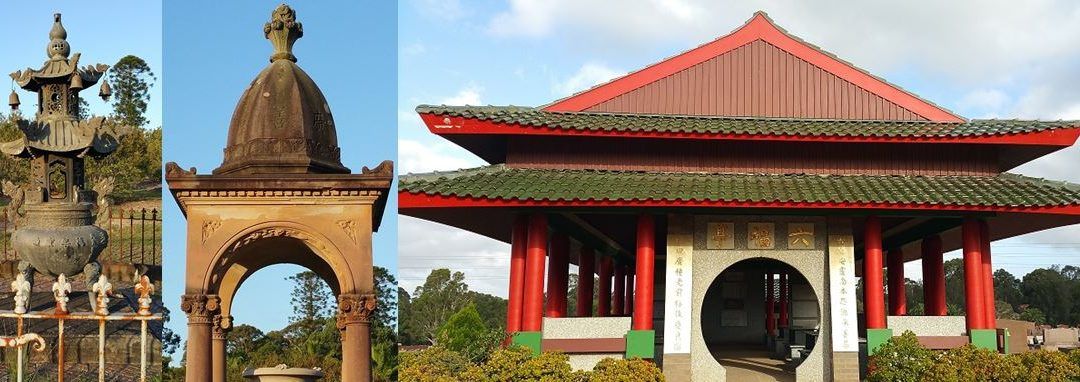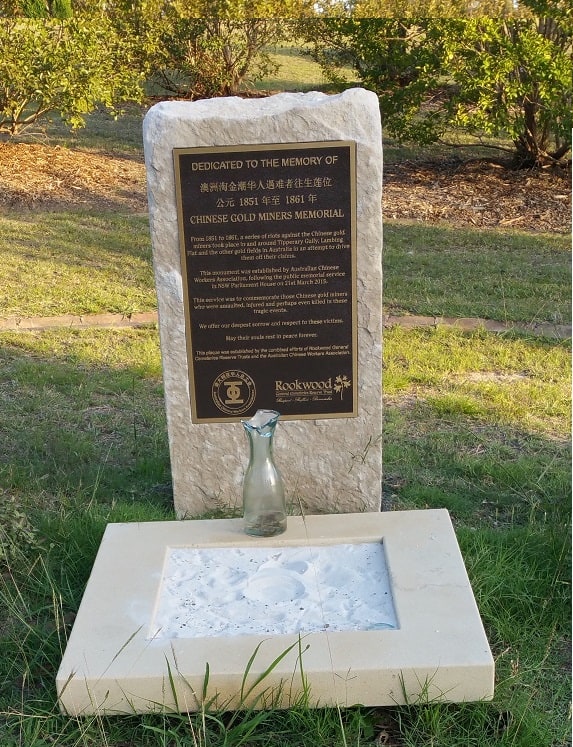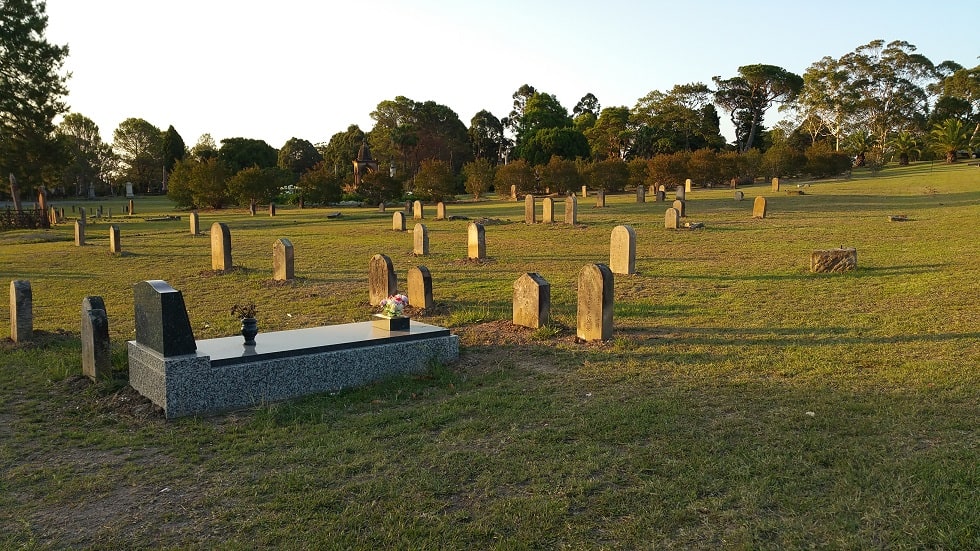
Rookwood Cemetery or officially the Rookwood Necropolis opened in 1865 and consecrated in 1867. At the time it was known as Haslem’s Creek Cemetery[1]. It is the largest cemetery in the southern hemisphere occupying 314 hectares[2] and is divided and managed by the Rookwood General Cemeteries Reserve Trust (responsible for two-thirds or over 190 hectares of Rookwood since 2012[3]), the Rookwood Necropolis Trust, the Catholic Metropolitan Cemeteries Trust (86 hectares[4]), Rookwood Memorial Gardens and Crematorium (InvoCare), and the Office of Australian War Graves. Now part of the Cumberland Council local government area in western Sydney, it is located in the suburb of Rookwood which is close in proximity to Lidcombe Railway Station, New South Wales. There are more than a million people, representing over 90 different religious and cultural groups calling Rookwood Cemetery their final resting place.[5]
For an overview history of Rookwood Cemetery, you can view their interactive timeline here – http://www.rookwoodcemetery.com.au/timeline
Majority of the Chinese in Sydney are interned there and may be buried within various denominational areas. Overtime certain sections have been allocated for the burial of Chinese ethnic origins like the Old Chinese and Old General areas within the “Old Ground” of the cemetery, and also the Independent Methodist area. Headstones with Chinese inscriptions have also been found covering the drain between Sections M and RRRR in the Anglican area, and are listed in Section M. These is also a Chinese section in Zone H which was selected because it met certain feng shui criteria.[6]
To find an individual grave, Roowood Cemetery has created a Deceased search database – http://www.rookwoodcemetery.com.au/deceased-search.
Click link for a map of the layout of Rookwood Cemetery to assist – http://www.rookwoodcemetery.com.au/assets/Map%20RGCRT%20Office%2022FEB16.pdf
Chinese deaths, funerals and burial practices outside China
In the Old Chinese Section of Rookwood Cemetery, you may notice that there are a lot of gaps among the headstones. This is because many Chinese immigrants were returned even after death to their Celestial ancestral village in the hopes of their spirits reunited with loved ones.
Death and traditional burial customs in China tended to follow a 3 stage process after the funeral rituals, but this could vary depending on the regionality, wealth, marital status, age and subsequent circumstances of the descendents of the deceased. The burial process involved an initial internment outside the home village, then after a certain period (about 7 years), exhuming and transferring the deceased’s bones to a ‘golden pagoda’ 金塔 (kam taap/ jinta/ Chin t’a) on an open hill outside the village and finally moving the urn with the deceased’s bone into the family vault in a good geomantic or feng shui location[7].
Burial practices of the overseas Chinese tended to follow similar rituals. As described by a Ballarat Star reporter observing a Chinese funeral:
After the body has been deposited in the grave some boughs are laid beside it. Candles are then lighted, and jostic is burnt, and a quantity of paper with Chinese characters upon them are consumed. It is customary to bring out potatoes, broiled fowls, pork, dumplings, and sweetmeats, together with brandy. Three glasses are filled with this liquor, which the chief person present raises to his lips, but does not drink, besides going through various bowings and genuflections. The sweetmeats are given away to the crowd who may be standing by, whilst the viands are taken back to the place from which they were fetched. The meaning of this peculiar ceremony is a peace offering on behalf of the deceased, to the evil spirit, in order to propitiate it.[8]
It was common practice for the Chinese to return their dead back to the ‘Celestial land’ to be buried there and reunite with their family after an initial internment in Australia. Funerals, burials and exhumations were often paid by families but a number were also paid for by the Tongs 堂, kinship groups, clans or societies that shared a close bond because they originated from the same village or district. One of the earliest Tong societies was ‘Quong Sing Tong’ which by 1877 had erected a monument in the Old Chinese section of Rookwood Cemetery.
As early as 1862, the firm Mollison and Black were arranging shipment of up to 200 remains of Chinese who had been exhumes from Sydney and rural burial grounds. The process involved applying to the Australian Health Department for exhumation and should the application be successful, undertakers exhumed the bodies under the supervision of the police to prevent the smuggling of gold outside the country.[9]
Based on the records of Rookwood Cemetery, an average of 55% to 65% (and peaking at 75%) of Chinese burials from the ‘Old Chinese section’ were returned to China between 1875 and 1930. For further numbers, see William’s Appendix IV, Table 7: Burials and Returns, p. 96.[10] Not until the mid 1930s did the shipment of bodies back to China being to die down.
Hong Kong was considered then a ‘safe haven’ for migrants as it was under British Crown rule from 1841 to 1997, so Tung Wah Hospital (established since 1870) was used as a stopover from Australia in sending the bones of the deceased back to their ancestral village (Williams, 1999, p. 13).
The State Archive and Records of New South Wales has exhumation files (NRS 4833) – https://www.records.nsw.gov.au/series/4833
These days as mentioned majority of Chinese still choose to be buried in Rookwood Cemetery. Doris Yau-Chong Jones’ 2003 publication Remembering the forgotten: Chinese gravestones in Rookwood cemetery 1917-1949 recorded over 1000 gravestones. Generally Chinese gravestones feature 3 columns of inscriptions. The central column is the name of the deceased. The right hand column (west) is the date and time of death and on the left hand column (east) is information on the original Chinese village the deceased comes from and their age at death. Although not all Chinese gravestones follow the same pattern. The House of Chinn website has created a guide to reading Chinese tombstones – http://houseofchinn.com/ChineseTombstones.html
Ching Ming 清明節and Chung Yung 重陽節
Today, there are many Chinese festivals associated with cemeteries and the dead. Those commonly practiced by Australia’s Chinese are:
- 清明節 Ching Ming or Tomb Sweeping Day or Ancestors Day which usually falls on the 4, 5 or 6 April based on the second of 24 solar terms on the traditional Chinese solar calendar. Ching Ming is the traditional time to tend to graves to show respects to one’s ancestors. It involves making offerings of food, burning paper money and other paper articles to help the spirit in the next world, lighting incense and in the past setting off firecrackers to scare away the evil spirits[11].
- 重陽節 Chung Yung or Double Ninth Festival 重九節 is held around October on the ninth day of the ninth month of the Chinese lunar calendar. Chung Yang is another grave sweeping day. Rooted in the legend of a Han dynasty (202 BC to 220 AD), it is considered good luck to go to high grounds to avoid wandering spirits of people who have not died a natural death or have not been accorded ancestral worship. Paper money and clothing are burnt in the cemetery burners and a grand feast is organised so that wandering spirits are properly fed and clad and are not tempted to claim a living substitute as a resting place.
Chinese Monuments in Rookwood Cemetery
Quong Sin Tong Shire 廣善堂
The oriental monument known as Quong Sing Tong in the general Old Chinese, section A of Rookwood Cemetery was erected in 1877. This shrine was originally in the centre of the Chinese section and used by the community as a shrine for funeral ceremonial purposes. Quong Sin Tong was one of the earliest Chinese societies in the state of New South Wales. Up until the 1950s, the society helped with the exhumation of Chinese graves from Rookwood Cemetery for reburial in China, in accordance with the beliefs and practices of the community. In 2008 restoration work saw it returned as close as possible to its original condition. Work included carving of a new sandstone urn, replacing the rusted fencing and repairs to the historic moat and entrance steps.[12]
Chinese World War II Pavilion – Luk Fook Tang 六福亭
‘Luk Fook’ is a Cantonese auspicious phonetic translation of the word Rookwood. Luk (六) is the number six. In Chinese it is considered a lucky number. Fook (福) means blessing and Tang (亭) is pavilion. The Chinese World War II memorial pavilion was opened in 1970 and provides a place for all to pay respect to those who fought in the war. It is located in the Chinese section H on the east side of Blashki Avenue. Overtime has been a significant meeting place during Ching Ming and Chung Yung for families and Tong societies to gather, prayer and distribute food that has been blessed.
Chinese Miners Memorial[13]
Established and revealed on 9 October 2016 in the Old Chinese section as part of a project initiated by the Australian Chinese Workers Association. The memorial commemorates the memory of the Chinese miners who were injured and killed in a series of anti-Chinese racial riots including Tipperary Gully, Lambing Flat (now Young) and other goldfields throughout Australia from 1851 to 1861.

Rookwood Cemetery Chinese Gold Miners Memorial in Old Chinese section – photo taken by Anne Tsang December 2016
Rookwood Necropolis railway[14]

Rookwood Cemetery No. 1 Mortuary Receiving Railway Station, 1867-1869 – photo taken by Anne Tsang December 2016
Another part of Rookwood Cemetery that deserves an honourable mention is the former Rookwood Necropolis railway line which was closed on 29 December 1948. Designed by colonial architect James Barnetthe, who also designed the Regent Street railway station, formerly known as the Mortuary railway station in Redfern. Construction started in 1864 and comprised of four stations within the cemetery grounds:
- 1 Mortuary Station Receiving House which in 1957 was purchased by the All Saints Anglican Church in Ainslie, Canberra as their new building. It was demolished, moved and reconstructed in Canberra. The All Saints Church still run their services from this building[15].
- 2 Mortuary Station which opened as Roman Catholic Platform on 31 December 1901
- 3 Mortuary Station
- 4 Mortuary Station
It was on these funeral train trips out from Redfern to Rookwood cemetery that a lack of cultural understandings of the Chinese customs and festivities (especially Ching Ming and Chung Yung) that led to complaints and conflict.[16] To remediate the situation, separate trains and timetables were rolled out.[17]
Some notable Chinese found buried in Rookwood Cemetery
- Mei Quong Tart – http://www.rookwoodcemetery.com.au/media/mei-quong-tart
- Reverend George Soo Hoo Ten – Chinese Anglican Minister
- Elizabeth Ten (nee Lett or Ah Lett), wife of Reverend Soo Hoo Ten
- James Henry Hong Fong (alias Tong James Sang) – Chinese Herald editor
- Henry Fine

- Anne Tsang, Research Assistant, City of Parramatta, Parramatta Heritage Centre, 2017
References
[1] The Haslem’s Creek cemetery : a bill to regulate the necropolis (1867, November 13). Empire, p. 2. Retrieved from http://nla.gov.au/nla.news-article60847014
James Jervis (1920, September 22) Place – maes of the district, The Cumberland Argus and Fruitgrowers Advocate p. 4. Retrieved from http://nla.gov.au/nla.news-article103256600
[2] NSW Dept. of Primary Industries (2013, March) ‘Rookwood’s history and values’ in Rookwood Necropolis: Draft Plan of Management, p.23. Retrieved from http://www.crownland.nsw.gov.au/__data/assets/pdf_file/0010/651763/Draft_Rookwood_Plan_of_Management_display_final_version_for_display_1_March_to_12_April_2013.PDF
[3] Rookwood General Cemeteries Reserve Trust (2016) Annual Report, p. 8. Retrieved from http://www.rookwoodcemetery.com.au/assets/Annual%20Reports/RGCRT_AR_2016.pdf
[4] Catholic Cemeteries and Crematoria (2015) Annual report 2015, p. 37. Retrieved from http://www.catholiccemeteries.com.au/wp-content/uploads/2013/11/151026_CCC_2015_annual_report.pdf
[5] Rookwood General Cemeteries Reserve Trust (2017) About Rookwood. Retrieved from http://www.rookwoodcemetery.com.au/about-us
[6] Jack Brook (2010) From Canton with courage : Parramatta and beyond Chinese arrivals 1800 – 1900, Seven Hills, N.S.W. : Jack Brook F.B.D.H.S. (Fellow Blacktown District Historical Society), pp. 178-185
Society of Australian Genealogists (n.d.) Rookwood sectional notes. Retrieved from http://catalogue.sag.org.au/attachments/31957/RookwoodSectionNotesAndMaps.pdf
[7] Terry Abraham & Priscilla Wegars (2003) Urns, bones and burners: overseas Chinese cemeteries, Australasian historical archaeology, 21, pp. 58-69. Retrieved from http://www.asha.org.au/pdf/australasian_historical_archaeology/21_04_Abraham.pdf
[8] Ballarat Star (1856, April 18) Chinese funeral, The Sydney Morning Herald, p. 4. Retrieved from http://nla.gov.au/nla.news-article12981948
[9] They Return to China. (1922, June 21). The Cumberland Argus and Fruitgrowers Advocate, p. 1. Retrieved from http://nla.gov.au/nla.news-article103305963
[10] Michael Williams, 1999, Chinese settlement in NSW : a thematic history : a report for the NSW Heritage Office of NSW, September 1999. Retrieved from http://www.environment.nsw.gov.au/resources/heritagebranch/heritage/chinesehistory.pdf
[11]La Trobe University Humanities and Social Science Asian Studies Program (n.d.) ‘Chinese Australia: Death and burial in Australia in the 18th and early 19th centuries’. Retrieved from https://arrow.latrobe.edu.au/store/3/4/5/5/1/public/FMPro7e48.html?-db=background.fp5&-format=format/background_record.htm&-lay=web&id=45&-max=1&-find=
Australian Museum (2009, October 22) Ching Ming. Retrieved from http://australianmuseum.net.au/ching-ming
[12] Jim Bar (2010, April 19) ‘Rookwood, Quong Sin Tong Monument’, Sydney – City and suburbs [blog]. Retrieved from
https://sydney-city.blogspot.com.au/2010/04/rookwood-quong-sin-tong-monument.html
Henri W. O. Yeung 楊永安 (2014) Lonely star on lonesome nights : a history of the Chinese Australians 1860-1940 長夜星稀 澳大利亞華人史, pp. 132.
[13] Winmas Yu (2016, October 6) http://www.sbs.com.au/yourlanguage/cantonese/en/content/monument-be-revealed-memory-chinese-victims-during-1851-gold-rush ;
Rookwood Cemetery (2016, October 10) Facebook post. Retrieved from https://www.facebook.com/RookwoodCemetery/photos/pb.162847728153.-2207520000.1476336502./10155305747033154/?type=3
[14] Allison Lee (2007) History of Mortuary Railway Stations : Rookwood Necropolis & Regent Street, Redfern. Retrieved from http://www.natrailmuseum.org.au/downloads/documents/Allison_Lee_History_of_Mortuary_Railway_Stations.pdf
[15] Front the end of the line to a place of hope (1965, November 26). The Canberra Times, p. 10. Retrieved from http://nla.gov.au/nla.news-article105875070 ; Michael Wayne (2012, July 8) ‘Rookwood Necropolis railway – Lidcombe, NSW’, Past/lives of the near future : revealing traces of a former Sydney [blog] Retrieved from https://pastlivesofthenearfuture.com/tag/haslams-creek/
[16] Chinese festivals in Rookwood Cemetery : To the Editor of the Herald (1883, October 13) The Sydney Morning Herald, p. 8. Retrieved from http://nla.gov.au/nla.news-article28371348
[17] Chinese festivals (1909, October 30).The Cumberland Argus and Fruitgrowers Advocate, p. 4. Retrieved from http://nla.gov.au/nla.news-article85916230
Chuimei Ho & Bennet Bronson, eds. (2015, October 26) Reburial: Exhuming the Dead and Returning Them to China 塵土歸路: 先友回唐 – 墓地 葬仪 过程, Chinese in Northwest America Research Committee (CINARC) [website]. Retrieved from http://www.cinarc.org/Death-2.html
Doris Yau-Chong Jones (2003) Remembering the forgotten: Chinese gravestones in Rookwood cemetery 1917-1949, Pymble, N.S.W.: Invenet.
David A. Weston, ed., Joan Sigrist & Laurel Burg (1989) The sleeping city: the story Rookwood Necropolis, Sydney: Hale & Iremonger.
Fracas between larrikins and Chinese at Rookwood Cemetery. (1886, April 7). The Sydney Morning Herald, p. 13. Retrieved from http://nla.gov.au/nla.news-article28356418
New South Wales Office of Environment and Heritage (n.d.) ‘Rookwood Cemetery and Necropolis’ (database number 5045470). Retrieved from http://www.environment.nsw.gov.au/heritageapp/ViewHeritageItemDetails.aspx?ID=5045470
Nicola Heath (2016, April 12) ‘Funeral customs around the world’, SBS Life [website]. Retrieved from http://www.sbs.com.au/topics/life/culture/explainer/funeral-customs-around-world
Shirley Fitzgerald (1996) Red tape, gold scissors : the story of Sydney’s Chinese, Sydney : State Library of New South Wales Press, pp. 53-62




